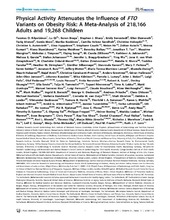| dc.contributor.author | Kilpeläinen, Tuomas O. | en_US |
| dc.contributor.author | Qi, Lu | en_US |
| dc.contributor.author | Brage, Soren | en_US |
| dc.contributor.author | Sharp, Stephen J. | en_US |
| dc.contributor.author | Sonestedt, Emily | en_US |
| dc.contributor.author | Demerath, Ellen | en_US |
| dc.contributor.author | Johansson, Stefan | en_US |
| dc.contributor.author | Njølstad, Pål Rasmus | en_US |
| dc.date.accessioned | 2012-02-29T09:41:41Z | |
| dc.date.available | 2012-02-29T09:41:41Z | |
| dc.date.issued | 2011-11-01 | eng |
| dc.Published | PLoS Med 8(11): e1001116 | en |
| dc.identifier.issn | 1549-1277 | |
| dc.identifier.uri | https://hdl.handle.net/1956/5660 | |
| dc.description | There are 116 authors. Only a few of them have been given author entries. | en |
| dc.description.abstract | Background: The FTO gene harbors the strongest known susceptibility locus for obesity. While many individual studies have suggested that physical activity (PA) may attenuate the effect of FTO on obesity risk, other studies have not been able to confirm this interaction. To confirm or refute unambiguously whether PA attenuates the association of FTO with obesity risk, we meta-analyzed data from 45 studies of adults (n=218,166) and nine studies of children and adolescents (n=19,268). Methods and Findings: All studies identified to have data on the FTO rs9939609 variant (or any proxy [r2.0.8]) and PA were invited to participate, regardless of ethnicity or age of the participants. PA was standardized by categorizing it into a dichotomous variable (physically inactive versus active) in each study. Overall, 25% of adults and 13% of children were categorized as inactive. Interaction analyses were performed within each study by including the FTO6PA interaction term in an additive model, adjusting for age and sex. Subsequently, random effects meta-analysis was used to pool the interaction terms. In adults, the minor (A2) allele of rs9939609 increased the odds of obesity by 1.23-fold/allele (95% CI 1.20–1.26), but PA attenuated this effect (pinteraction = 0.001). More specifically, the minor allele of rs9939609 increased the odds of obesity less in the physically active group (odds ratio = 1.22/allele, 95% CI 1.19–1.25) than in the inactive group (odds ratio = 1.30/ allele, 95% CI 1.24–1.36). No such interaction was found in children and adolescents. Conclusions: The association of the FTO risk allele with the odds of obesity is attenuated by 27% in physically active adults, highlighting the importance of PA in particular in those genetically predisposed to obesity. | en_US |
| dc.language.iso | eng | eng |
| dc.publisher | Public Library of Science | eng |
| dc.rights | Attribution CC BY | eng |
| dc.rights.uri | http://creativecommons.org/licenses/by/2.5/ | eng |
| dc.title | Physical Activity Attenuates the Influence of FTO Variants on Obesity Risk: A Meta-Analysis of 218,166 Adults and 19,268 Children | en_US |
| dc.type | Peer reviewed | |
| dc.type | Journal article | |
| dc.description.version | publishedVersion | en_US |
| dc.rights.holder | Copyright 2011 Loos et al. | |
| dc.identifier.doi | https://doi.org/10.1371/journal.pmed.1001116 | |
| dc.subject.nsi | VDP::Medical disciplines: 700::Basic medical, dental and veterinary science disciplines: 710::Medical genetics: 714 | eng |

